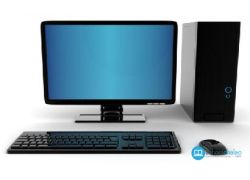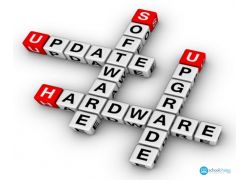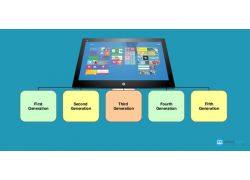Tutorial Library
Learning Point
types of computer
Types of Computers?
• Desktop computers
• Workstations
• Notebook (or laptop) computers
• Tablet computers
• Handheld computers
• Smart phones There are four main types of multi-user computers:
• Network servers
• Mainframe computers
• Minicomputers
• Supercomputers
DESKTOP COMPUTERS
The most common type of personal computer is the desktop computer—a PC that is designed to sit on (or more typically under) a desk or table. Today’s desktop computers are powerful and versatile, and they are used for an amazing array of tasks. Not only do these machines enable people to do their jobs with greater ease and efficiency, but they can be used to communicate, produce music, edit photographs and videos, play sophisticated games, and much more. Used by everyone from preschoolers to nuclear physicists, desktop computers are indispensable for learning, work, and play. As its name implies, a desktop computer is a full-size computer that is too big to be easily carried around. The main component of a desktop PC is the system unit, which is the case that houses the computer’s critical parts, such as it’s processing and storage devices.
WORKSTATIONS
A workstation is a specialized, single-user computer that typically has more power and features than a standard desktop PC. These machines are popular among scientists, engineers, and animators who need a system with greater-than-average speed and the power to perform sophisticated tasks. Workstations oft en have large, high-resolution monitors and accelerated graphics-handling capabilities, making them suitable for advanced a rchitectural or engineering design, modeling, animation, and video editing.
NOTEBOOK COMPUTERS
Notebook computers, as their name implies, approximate the shape of a writing notebook and easily fi t inside a briefcase. Because people frequently set these devices on their lap, they are also called laptops. Notebooks have a “clam-shell” design; during use, the notebook’s lid is raised to reveal a thin monitor and a keyboard. When not in use, the device folds up for easy storage. Notebooks are fully functional microcomputers; the people who use them need the power of a.
TABLET PCS
The tablet PC is the newest development in portable, full-featured computers. Tablet PCs offer all the functionality of a notebook PC, but they are lighter and can accept input directly from a special pen—called a stylus or a digital pen—or even the user’s fingers. Some of the newer models can display an image of a keyboard on the screen and allow the user to type. Many tablet PCs also have a built-in microphone and special soft ware that accepts input from the user’s voice. A few models even have a fold-out keyboard, so they can be transformed into a standard notebook PC. Tablet PCs run specialized versions of standard programs and can be connected to a network. The popularity of tablet PCs has exploded in recent years both for business and personal use. The combination of portable size and friendly interface makes them ideal in a wide range of circumstances for note-taking, document sharing, and online communication.
HANDHELD PCS
Handheld personal computers (or just handheld PCs) are computing devices small enough to fit in your hand. Handheld PCs are typically used for applications that help connect mobile users to online resources; provide portable entertainment in the form of games, music and video; and assist with mobile computing tasks such as taking notes and managing address books or task lists.
NETWORK SERVERS
A network server is a powerful personal computer with special software and equipment that enable it to function as the primary computer in the network. Though their exact functions are different from organization to organization, network servers all have the basic task of making documents, programs, and in some cases other computer hardware available to others. For example, a network server might run the e-mail services for a company. Rather than having each employee run his or her own mail program, employees simply access the central e-mail program running on the server to retrieve their messages. Network servers are also responsible for sending Web pages to users who are browsing the Internet; a single server can send its Web pages to thousands of people visiting the site that it hosts.
MAINFRAME COMPUTERS
Mainframe computers are large, powerful systems used in organizations such as insurance companies and banks, where many people frequently need to use the same data. In a traditional mainframe environment, each user accesses the mainframe’s resources through a device called a terminal. There are two kinds of terminals. A dumb terminal does not process or store data; it is simply an input/output (I/O) device that functions as a window into a computer located somewhere else. An intelligent terminal can perform some processing operations, but it usually does not have any storage. In some mainframe environments, however, workers can use a standard personal computer to access the mainframe. The largest mainframes can handle the processing needs of thousands of users at any given moment. But what these systems offer in power, they lack in flexibility. Most mainframe systems are designed to handle only a specific set of tasks. In your state’s Department of Motor Vehicles, for example, a mainframe system is probably devoted to storing information about drivers, vehicles, and driver’s licenses, but little or nothing else. By limiting the number of tasks the system must perform, administrators preserve as much power as possible for required operations.
MINI COMPUTERS
First released in the 1960s, minicomputers got their name because of their small size relative to other computers of the day. The capabilities of a minicomputer are somewhere between those of mainframes and personal computers. For this reason, minicomputers are oft en called midrange computers. Like mainframes, minicomputers can handle much more input and output than personal computers. Although some “minis” are designed for a single user, the most powerful minicomputers can serve the input and output needs of hundreds of users at a time. Users can access a central minicomputer through a terminal or a standard PC.
SUPER COMPUTERS
Supercomputers are the most powerful computers and physically they are some of the largest. These systems can process huge amounts of data, and the fastest supercomputers can perform nearly two quadrillion calculations per second.
Very Useful (0)
Useful (0)
Not Useful (0)
Please login to your account by completing this form
Reset Your password
Please enter the email address you signed up with and we'll send you a password reset link.
A reset password link has been generated and will be sent to you via email.
You can then follow that link and select a new password.
Completing that action will allow you to reset your password and then you can insert a new one.
Please enter the email address you signed up with and we'll send you a password reset link.
A reset password link has been generated and will be sent to you via email.
You can then follow that link and select a new password.
Completing that action will allow you to reset your password and then you can insert a new one.


